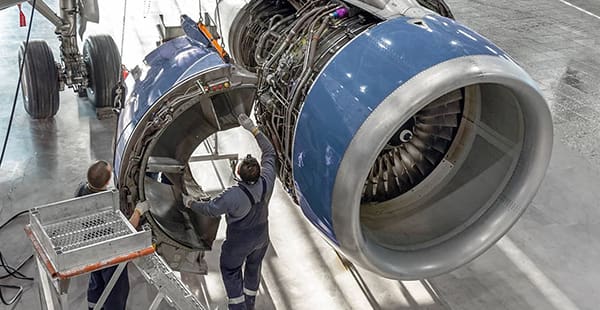01. Asbestos Risk
How Are Aircraft Mechanics Exposed to Asbestos?
Civilian and military aircraft mechanics ensure aircraft are flight ready. This includes performing repairs, inspections and general maintenance.
Before the 1980s, manufacturers of aircraft parts often used asbestos. The mineral was useful in the industry because of its durability and fire resistance. Common parts made with asbestos were brake pads, gaskets and valves. Because aircraft mechanics worked with these parts, their risk of asbestos exposure was high.
When installing or repairing asbestos-containing aircraft components, asbestos fibers can become airborne. Mechanics may inhale or ingest these fibers. Asbestos exposure like this can lead to diseases such as mesothelioma.
Although regulations now limit asbestos use, aircraft mechanics may still be at risk. Mechanics who work on older airplanes may handle some parts that contain asbestos.
What Asbestos Products Put Aircraft Mechanics at Risk?
Since the early 1900s, many companies supplied the aviation industry with asbestos products. These included asbestos insulation, sealants and fireproof equipment like asbestos gloves and blankets. Aircraft mechanics may have come into contact with these products during their day-to-day work.
Aircraft mechanics may have been exposed to asbestos from:
- Adhesives
- Asbestos blankets
- Asbestos gloves and other textiles
- Brake pads
- Cockpit heating systems
- Engine and electrical insulation
- Engine mounts
- Engine shields
- Engine shrouds
- Epoxy
- Gaskets
- Insulation
- Repair equipment
- Valves
Despite knowing the dangers of asbestos, companies used the mineral for decades. These companies continue to put aircraft mechanics and related workers at risk.
Common Places Aircraft Mechanics May Find Asbestos
Civilian and military aircraft mechanics may risk occupational asbestos exposure at various jobsites. Civilian employees may work for an airline, repair hangar or a private company. Military employees may work at an Air Force base in the United States or abroad.
Aircraft mechanics work in different areas of an aircraft. Many of these areas may have previous or ongoing asbestos contamination.
Locations in aircraft that often exposed aircraft mechanics to asbestos include:
- Brake systems
- Cockpits
- Engines
- Fuselages
- Landing gears
- Propellers
- Tail assemblies
- Wings
Today, asbestos use is more restricted in the United States. However, aircraft with older parts may still put mechanics at risk of exposure. Aircraft mechanics may also be at higher risk of inhaling asbestos fibers. This is especially true while they’re working in enclosed spaces, such as the cockpit.
Aircraft Mechanics and At-Risk Trades
Besides aircraft mechanics, other jobs in aviation may put workers at risk of asbestos exposure. These jobs involve similar tasks and may have used the same asbestos products.
Other at-risk trades in the aviation industry are:
- Aerospace engineers and technicians
- Air Force members and veterans
- Automotive body and glass repairers
- Automotive service technicians
- Diesel service technicians and mechanics
- Electrical engineers and technicians
- Electrical installers and repairers
- Electricians
- Electro-mechanical technicians
- Heavy vehicle and mobile equipment service technicians
- Insulation installers
- Machinists
- Mechanical engineers and technicians
Besides occupational exposure, secondary asbestos exposure can also put families at risk. Family members may be exposed if mechanics bring asbestos-contaminated clothing into the home.
02. Mesothelioma Risk
Mesothelioma Risk for Aircraft Mechanics
Retired and current aircraft mechanics may be at risk of developing asbestos-related illnesses. Symptoms of asbestos-related diseases, such as mesothelioma, can take decades to present. Asbestos lung cancer and asbestosis may also start years after exposure.
In 2010, scientists analyzed four studies about mesothelioma and aircraft mechanics. They found relatively high asbestos content in products routinely handled by aircraft mechanics. These products include brakes, which contain 16% – 23% asbestos by weight.
People who handled asbestos parts may later develop health issues. But those diagnosed with mesothelioma have options. They may be eligible to file a lawsuit or bankruptcy trust fund claim.
03. Compensation
Compensation for Aircraft Mechanics With Occupational Asbestos Exposure
Mesothelioma patients, including aircraft mechanics, have filed lawsuits against companies for asbestos exposure. Major aviation companies like Lockheed Martin Corporation and Boeing Company sometimes face lawsuits. Lawsuits can provide financial compensation to aircraft mechanics and their loved ones. This compensation may come from a jury verdict or settlement.
Experienced mesothelioma lawyers can explain lawsuits and other legal options. Some asbestos disease victims are eligible to file mesothelioma trust fund claims.
Another option for those exposed on the job may be workers’ compensation. Because military aircraft mechanics are also at risk, they may be eligible to file a VA claim.
Mesothelioma law firms can help victims pursue their best legal options.
04. Asbestos Safety
Asbestos Safety for Aircraft Mechanics
The Environmental Protection Agency (EPA) oversees federal regulations for asbestos. The Occupational Safety and Health Administration (OSHA) also manages workplace safety for asbestos. The aviation industry follows these standards for asbestos handling and disposal.
The Federal Aviation Administration has more regulations specific to avionics. In 2019, the agency issued an asbestos management order. It aims to protect workers in Air Traffic Organization facilities.




